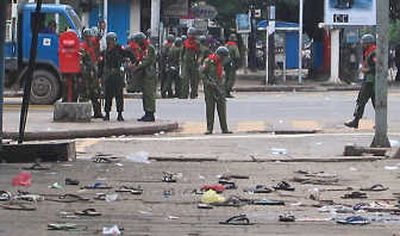Military crackdown kills at least nine

NEW DELHI – As thousands of angry residents continued to pour onto the streets of Yangon in defiance of an official ban, Myanmar’s military dictatorship tightened its clampdown on protests Thursday in a show of force that left at least nine people dead.
Among those killed in clashes in the nation’s capital was a Japanese photographer shot while trying to capture images of the large-scale demonstrations that have offered the repressive ruling junta its most powerful challenge in nearly 20 years.
Eyewitness accounts, television footage and photographs beamed through cell phones showed security forces with riot shields marching down Yangon’s boulevards on the second day of an increasingly brutal crackdown.
Security forces fired tear gas and warning shots from automatic weapons to disperse the crowds, which scurried for cover, leaving behind sandals in their haste and pools of blood where the face-off turned violent.
The spiraling unrest stoked fears of a repeat of a 1988 massacre of pro-democracy protesters in which an estimated 3,000 people were killed in the Southeast Asian nation, also known as Burma.
Even China, Myanmar’s traditional ally, issued a public admonition to the country’s military regime to proceed with caution, after having joined with Russia to block an official condemnation Wednesday by the United Nations.
Up to 70,000 people ignored government warnings to stay home and marched through the streets of Yangon, also known as Rangoon, for a 10th day of protests, according to news reports and dissident groups in exile.
Whereas previous rallies had been led by Buddhist monks, who are revered in Burmese society, fewer clerics turned out Thursday, most likely because government forces raided at least six monasteries before dawn and reportedly beat and arrested scores of people.
The majority of demonstrators Thursday appeared to be ordinary citizens, some of whom shouted for freedom from the military rule that has driven their country into poverty and isolation.